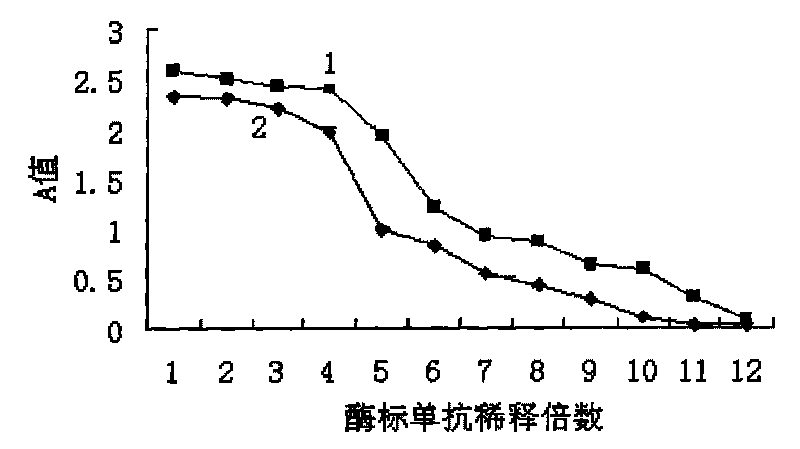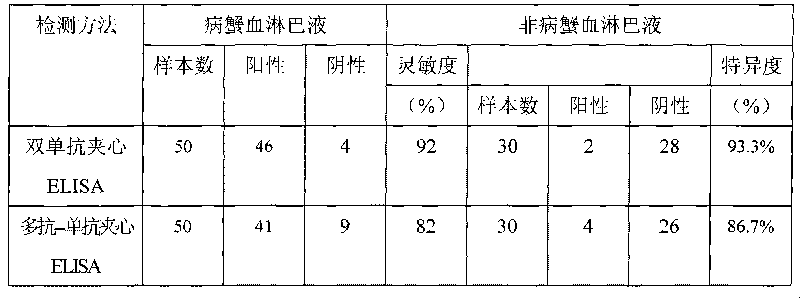Methods for detecting bicistronic mRNA virus of scylla serrata and kits thereof
A bicistronic and mud crab technology, applied in the field of mud crab breeding biology, can solve problems that have not been reported before, and achieve high specificity, high specificity detection, and high sensitivity
- Summary
- Abstract
- Description
- Claims
- Application Information
AI Technical Summary
Problems solved by technology
Method used
Image
Examples
Embodiment 1
[0060] The method of embodiment 1HRP labeling antibody
[0061] In this embodiment, the sodium periodate method is used to prepare and purify the HRP enzyme-labeled MCDV monoclonal antibody. The specific steps are as follows:
[0062] (1) Weigh 5mg HRP and dissolve it in 0.5ml distilled water, add freshly prepared 0.06mol / l NaIO 4 Aqueous solution 0.5ml, mix well and place in 4℃ refrigerator for 30min;
[0063] (2) Take out and add 0.5ml of 0.16mol / l ethylene glycol aqueous solution, room temperature for 30min, add 1ml of aqueous solution containing 5mg of purified monoclonal antibody, mix well, protect from light, slowly stir, transfer to dialysis bag, at 0.01MpH4.4 Acetic acid buffer was dialyzed overnight at 4°C; the monoclonal antibody was a monoclonal antibody to MCDV structural protein 1, a monoclonal antibody to MCDV structural protein 2 or a monoclonal antibody to MCDV structural protein 3;
[0064] (3) Mix HRP: monoclonal antibody at four mass ratios of 3:1, 2:1, 1:...
Embodiment 2
[0070] The selection of embodiment 2 enzyme-labeled antibody working concentration
[0071] In the immunoenzyme technique, the selection of the working concentration of the enzyme-labeled antibody has a great influence on the whole test. Therefore, the working concentration must be accurately titrated before the formal test.
[0072] The antigen (or antibody) is physically adsorbed on a solid-phase carrier, and then a series of diluted enzyme-labeled antibodies (or anti-Ig antibodies) react with the antigen (or antibody) adsorbed on the carrier, and the reaction between the enzyme and the substrate The degree of color reaction is used to determine the titer of the enzyme-labeled antibody, or the working concentration.
[0073] 1. Determine the optimal working concentration of the enzyme-labeled antibody
[0074] This embodiment adopts the indirect ELISA method to determine the working concentration of the enzyme-labeled antibody. The steps are: first dilute the antigen (100 n...
Embodiment 3
[0077] Example 3 Enzyme-labeled antibody immune activity assay
[0078] Enzyme-labeled antibody immune activity assay: first coat the antigen (in the hemolymph of crabs infected with MCDV), use the enzyme-labeled MCDV monoclonal antibody as the primary antibody, and dilute the enzyme-labeled antibody (1:100x2 n , n=0, 1, 2, 3...11), then add the substrate chromogenic solution TMB, after color development, use 2M H 2 SO 4 0.05ml to stop the reaction, the dual-wavelength microplate reader measures the A450 / A630 value. A450 / A630≥1.0 was judged as positive.
[0079] The results are shown in Table 1. The A450 / A630 value of the monoclonal antibody against structural protein 1 was 1.003 at 1:16400, and the immunological activity of the enzyme-labeled antibody of the monoclonal antibody against structural protein 1 reached 1:6400, while the value of the enzyme-labeled antibody against structural protein 3 was 1:6400. The A450 / A630 value of the monoclonal antibody is 1.201 at 1:128...
PUM
 Login to View More
Login to View More Abstract
Description
Claims
Application Information
 Login to View More
Login to View More - R&D
- Intellectual Property
- Life Sciences
- Materials
- Tech Scout
- Unparalleled Data Quality
- Higher Quality Content
- 60% Fewer Hallucinations
Browse by: Latest US Patents, China's latest patents, Technical Efficacy Thesaurus, Application Domain, Technology Topic, Popular Technical Reports.
© 2025 PatSnap. All rights reserved.Legal|Privacy policy|Modern Slavery Act Transparency Statement|Sitemap|About US| Contact US: help@patsnap.com



